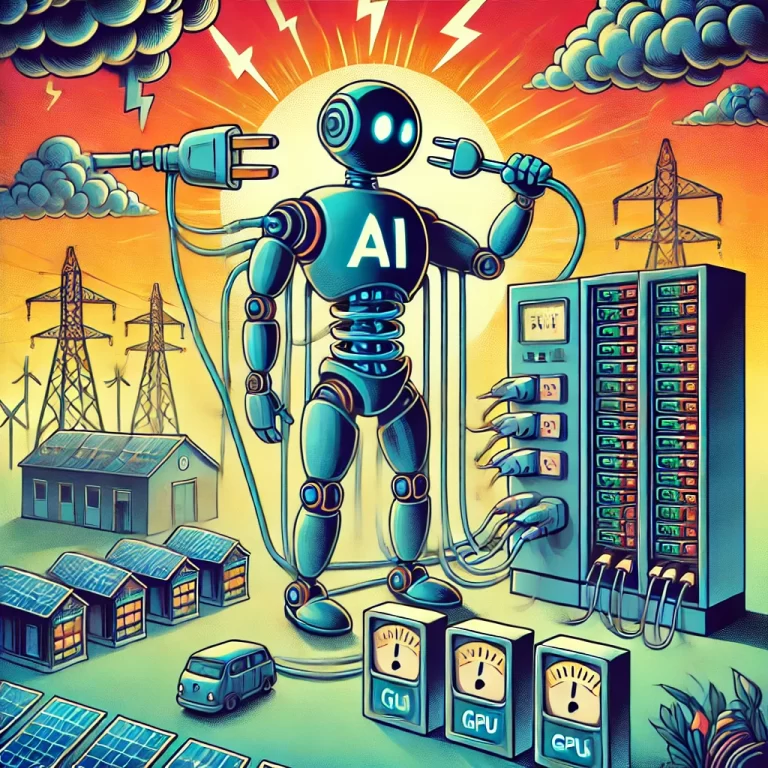AI The Electricity Eating Monster: Donald Trump

Listen To This Blog Here
Donald Trump did express concerns about the high electricity consumption of AI technology in a conversation with Elon Musk. During the discussion, he described AI as demanding “almost double” the current electricity production capacity of the United States, emphasizing his surprise at the amount of power needed to support AI’s operations. This concern reflects broader worries about the growing energy demands of AI and data centers, which have led some experts to suggest that AI could eventually consume up to a quarter of the U.S. energy supply if efficiency measures aren’t implemented.
Source1 – Cleantechnica
Source2 – BENZINGA
READ DETAILS HERE – The rise of artificial intelligence (AI) has undeniably brought transformative changes across industries, but it comes with a significant demand for electricity, raising concerns about its long-term sustainability. Let’s explore just how much electricity the new AI era requires, the challenges this presents, and what can be done to make AI more energy-efficient.
How Much Electricity Will AI Need?
AI models, particularly large-scale ones like GPT-4, Google’s DeepMind, and other generative AI models, are extremely power-hungry. The training process for these models involves processing vast amounts of data and requires substantial computing power. According to recent estimates:
AI Model Training: Training a single large AI model can consume as much energy as a city of 100,000 people over several weeks. For example, training GPT-3 reportedly required around 1,287 MWh of electricity, equivalent to the annual consumption of around 120 American homes.
Data Centers and AI: AI workloads are primarily run in data centers, which are already responsible for around 1% of the world’s electricity consumption. This number is expected to increase as AI adoption continues to surge. By 2030, data centers alone could consume up to 8% of global electricity, with AI being a significant driver.
AI-Powered Industries: Industries adopting AI solutions, from self-driving cars to smart cities, will further amplify the demand for power. For instance, AI-enabled autonomous vehicles and robotics require continuous real-time data processing, which consumes considerable energy.
Is AI an Electricity-Eating Monster?
Yes, in some ways, AI can be seen as an electricity-consuming monster, especially given the current trajectory of model sizes and the computational power required. The reasons for this include:
Model Size and Complexity: AI models have grown exponentially. For instance, GPT-4 is vastly more complex than its predecessors, demanding far more power to train and deploy. As models continue to scale, so does their energy consumption.
Increased Demand for GPUs: The need for specialized hardware like GPUs (Graphics Processing Units) and TPUs (Tensor Processing Units) drives up energy usage. NVIDIA, one of the leading providers of AI chips, has seen skyrocketing demand, which has put additional pressure on energy resources.
Cooling Requirements: Data centers running AI workloads generate substantial heat, requiring sophisticated cooling systems, which themselves consume large amounts of electricity.
How Can AI be Made More Energy Efficient?
To prevent AI from becoming an unsustainable electricity hog, several strategies can be adopted to make it more energy-efficient:
Optimizing AI Algorithms: Researchers are focusing on algorithmic efficiency to reduce the computational power required without sacrificing performance. Techniques like model pruning, quantization, and knowledge distillation can reduce model sizes while maintaining accuracy.
Energy-Efficient Hardware: Companies like NVIDIA, Intel, and Google are developing AI-specific chips designed to be more energy-efficient. Google’s TPUs and NVIDIA’s latest H100 GPUs are examples of hardware optimized for lower power consumption while delivering high performance.
Renewable Energy for Data Centers: Many tech giants, including Google and Microsoft, are investing in renewable energy sources to power their data centers. For example, Google’s data centers aim to be carbon-free by 2030, significantly reducing their environmental impact.
Liquid Cooling Systems: Advanced liquid cooling systems can be more efficient than traditional air cooling, reducing the energy needed to keep data centers operational.
Edge Computing: Shifting AI computations closer to the edge (i.e., on local devices rather than in centralized data centers) can reduce energy consumption by minimizing data transmission and processing.
Federated Learning: This technique allows AI models to be trained across decentralized devices (like smartphones), reducing the need for centralized, energy-intensive computing power.
The Future Outlook
The AI industry is aware of its growing environmental impact and is investing heavily in making AI more sustainable. However, with AI technologies like autonomous vehicles, IoT, and smart cities set to expand, the need for innovative solutions to curb energy consumption is more crucial than ever.
In summary, while AI does present challenges in terms of energy use, there are multiple pathways to mitigate its impact. The focus moving forward will be on sustainable AI—balancing innovation with environmental responsibility.

Syed Saif the founder and CEO of Brainow Consulting. He has over 24 Years of experience in Quality, Excellence, Innovation, Six Sigma, Lean, and Customer Services. He is a Certified Master Black Belt, ISO Lead Auditor, High Impact Trainer, Certified Business Excellence Assessor, Certified on Innovation Business Model Canvas, and holds a PG diploma in Customer Relationship Management. Syed Saif has trained thousands of people, from students to CEOs on various improvement methodologies and self help techniques, and has worked in various industries including BPO, Telecom, IT, Insurance, Manufacturing, and Healthcare. Prior to his full-time consulting role, he served as Vice President for a Leading Insurance Company and as National Head of Quality, Innovation, and Service for Corporate and Sales Functions. See our services page for more details on what we do and how can we help you and your organization.